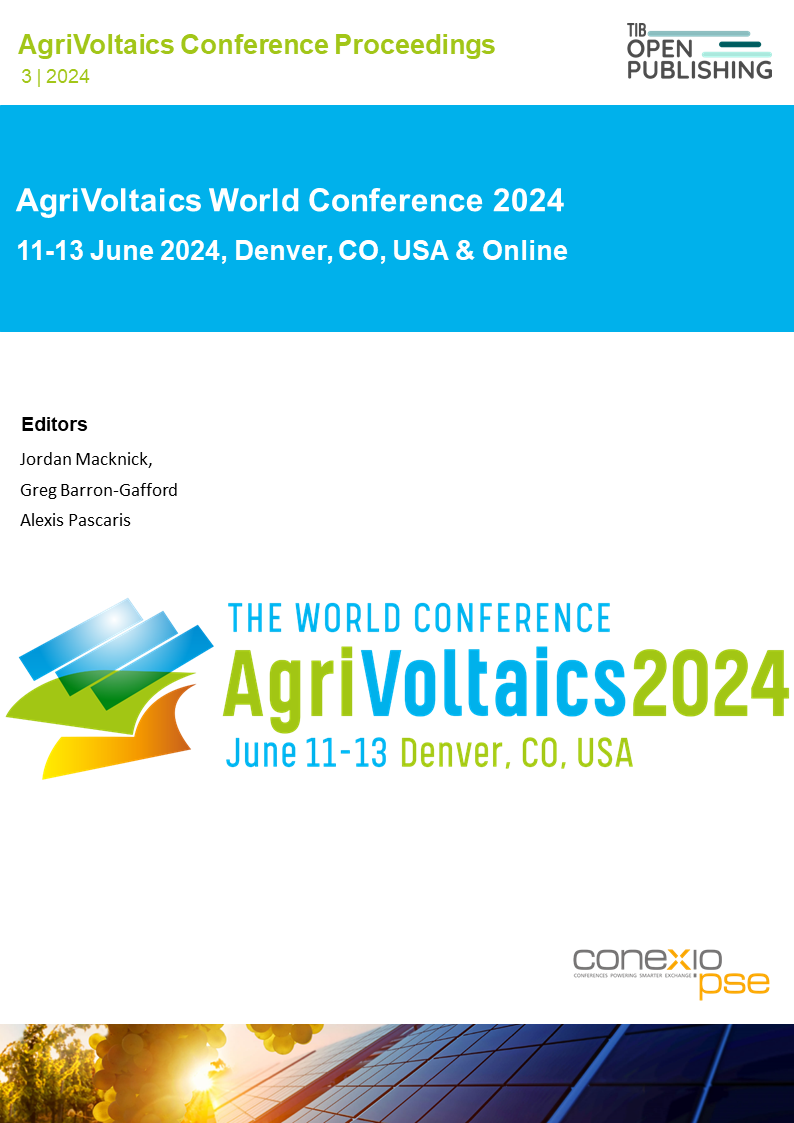Agrivoltaics Crop Yield Modeling
Quantifying the Effects of Light Limitations on Crop Growth
DOI:
https://doi.org/10.52825/agripv.v3i.1361Keywords:
Environmental Modeling, Crop Modeling, Crop Yields, PROMETAbstract
Agrivoltaics (APV) combine agriculture and photovoltaic (PV) energy production on the same land and have the potential to provide several synergies for both production systems. Moving towards large-scale commercial implementation, synergies and trade-offs need to be quantified. Various APV designs exist and have been studied in field experiments in the past. In addition to PV design choices, differences respecting the crops grown, the soil conditions and the climatic conditions are known to affect crop yields. However, it is unclear how planned APV sites with conditions that differ from the known research sites will perform. This poses challenges in terms of assessing the implications for both farmers and APV planners. Therefore, we developed a framework for simulating impacts of APV shading effects on crop yields. A new APV shading model is developed to specifically match the needs of the PROMET crop model, which is capable of worldwide simulations for a large range of crop types. When compared to results from the state-of-the art bifacial radiance raytracing model, similar trends and magnitudes in irradiance reductions have been observed. Agricultural yield prediction simulations for a planned BayWa r.e. APV project in France were used as a test case. The simulation results showed large differences between one-in-portrait and two-in-portrait trackers. The simulated crop yields for the site remain only within an acceptable range for winter wheat and rapeseed with 1P trackers. While the shading model and PROMET have already been tested individually, a more in-depth validation of the entire framework is planned for the near future, when data for planned systems becomes available. The addition of the APV shading model expands capabilities of the PROMET crop model towards APV simulation and allows for future development of advanced APV-related data products.
Downloads
References
G. A. Barron-Gafford, M. A. Pavao-Zuckerman, R. L. Minor, L. F. Sutter, I. Barnett-Moreno, D. T. Blackett, M. Thompson, K. Dimond, A. K. Gerlak, G. P. Nabhan, and J. E. Macknick, “Agrivoltaics provide mutual benefits across the food–energy–water nexus in drylands,” Nat Sustain, vol.2, no.9, pp. 848–855, Sep., 2019, doi: https://doi.org/10.1038/s41893-019-0364-5.
U. Jamil, A. Bonnington, and J. M. Pearce, “The Agrivoltaic Potential of Canada,” Sus-tainability, vol.15, no.4, 3228, Feb. 2023, doi: https://doi.org/10.3390/su15043228.
A. Weselek, A. Ehmann, S. Zikeli, I. Lewandowski, S. Schindele, and P. Högy, “Agropho-tovoltaic systems: applications, challenges, and opportunities. A review,” Agron Sustain, vol.39, no.4, Jun., 2019, Art. No. 35, doi: https://doi.org/10.1007/s13593-019-0581-3.
T. B. Hank, H. Bach, and W. Mauser, “Using a Remote Sensing-Supported Hydro-Agroecological Model for Field-Scale Simulation of Heterogeneous Crop Growth and Yield: Application for Wheat in Central Europe,” Remote Sens, vol.7, no.4, pp. 3934-3965, Apr., 2015, doi: https://doi.org/10.3390/rs70403934.
W. Mauser and S. Schädlich, “Modelling the spatial distribution of evapotranspirationon different scales using remote sensing data,” J. Hydrol., Dec., vol. 212–213, 1998, pp. 250-267, 1998, doi: https://doi.org/10.1016/S0022-1694(98)00228-5.
W. Mauser and H. Bach, “PROMET - Large scale distributed hydrological modelling to study the impact of climate change on the water flows of mountain watersheds”, J. Hy-drol., vol.376, no.3-4, pp. 362-377, Oct., 2009, doi: https://doi.org/10.1016/j.jhydrol.2009.07.046.
T. B. Hank, “A Biophysically Based Coupled Model Approach for the Assessment of Canopy Processes under Climate Change Conditions,” Ph.D. dissertation, Fac. of Ge-osci., LMU München, Munich, Germany, 2008, doi: https://doi.org/10.5282/edoc.8725.
S. Ayala Pelaez and C. Deline, “bifacial_radiance: a python package for modeling bifacial solar photovoltaic systems,” J. Open Source Softw, vol.5, no.50, p. 1865, Jun., 2020, doi: https://doi.org/10.21105/joss.01865.
W. F. Holmgren, C. W. Hansen, and M. A. Mikofski, “pvlib python: a python package for modeling solar energy systems,” J. Open Source Softw, vol.3, no.29, p. 884, Sep., 2018, doi: https://doi.org/10.21105/joss.00884.
Deutscher Wetterdienst, 2020. “ICON-EU regional model NWP data,” distributed by Deutscher Wetterdienst Open Data Server, https://opendata.dwd.de/weather/nwp/icon-eu
European Commission Joint Research Centre Energy Efficiency and Renewables Unit, 2022. “Photovoltaic Geographical Information System PVGIS-ERA5 2005-2020 typical meteorological year data,“ distributed by European Commission, https://re.jrc.ec.europa.eu/pvg_tools/en/tools.html
Published
How to Cite
Conference Proceedings Volume
Section
License
Copyright (c) 2025 Felix Schuck, Heike Bach, Erion Bousi, Stephan Schindele

This work is licensed under a Creative Commons Attribution 4.0 International License.
Accepted 2025-03-05
Published 2025-03-27
